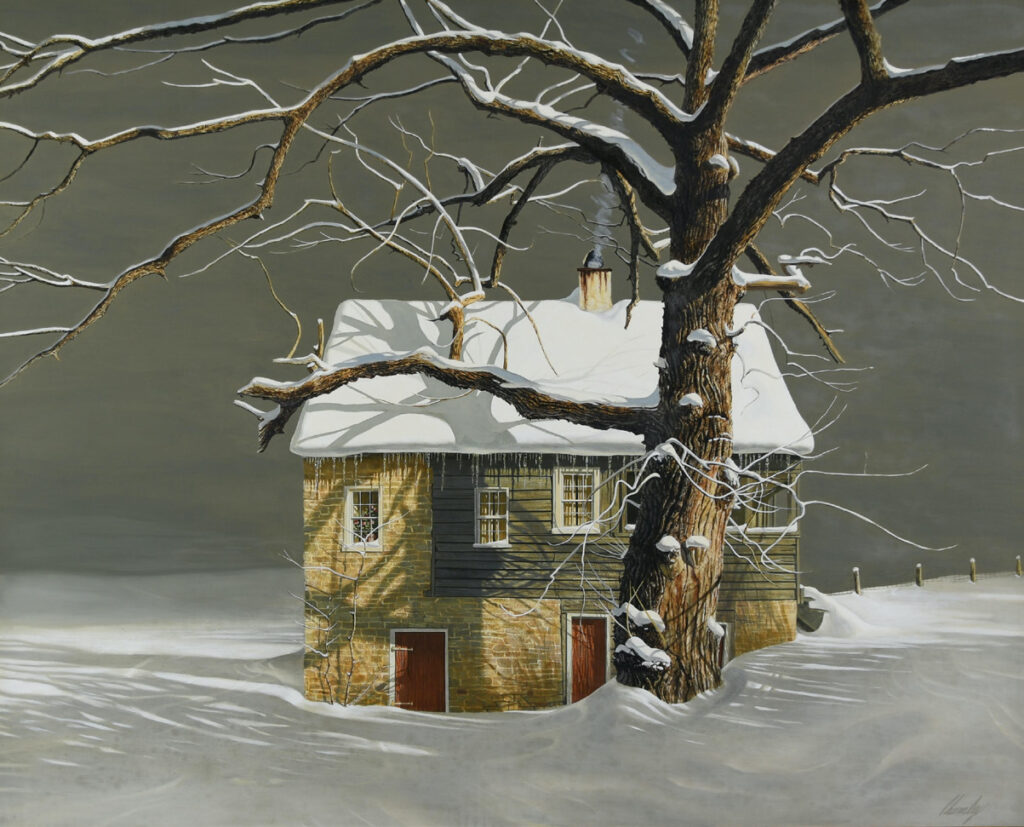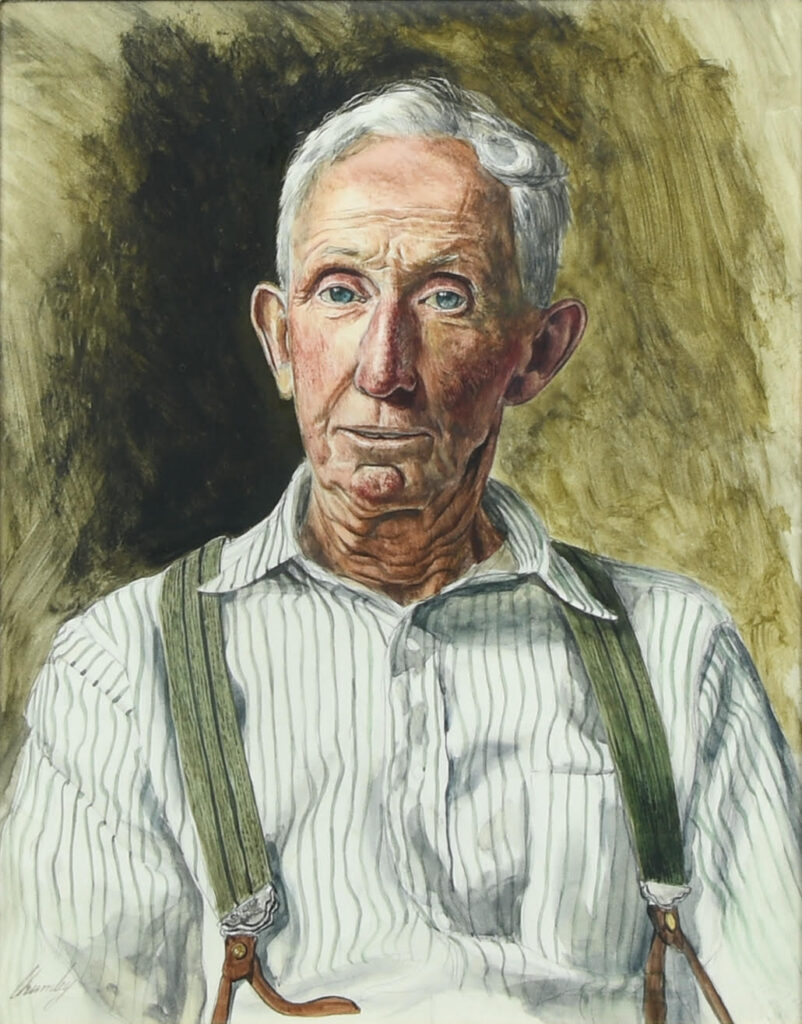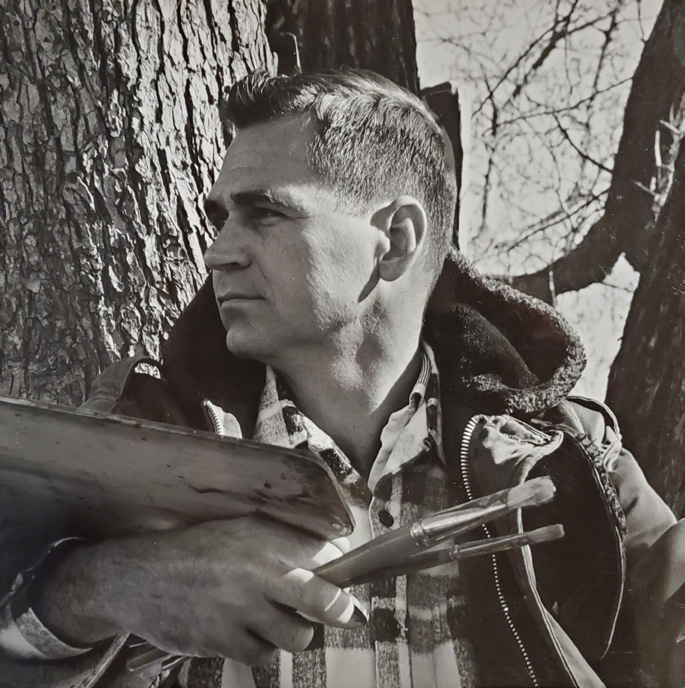By A. Nicholas Powers, Curator of Collections, Museum of the Shenandoah Valley.

With Lyric Brush: John Chumley’s Valley was recently featured at the Museum of the Shenandoah Valley in Winchester, Virginia. One of the most talented artists to live and paint in Virginia’s Shenandoah Valley, John Chumley offers intimate glimpses into the rural ways of life and landscapes of the Old Dominion. With Lyric Brush was the first major retrospective of Chumley’s art since his early death from colon cancer in 1984 at the age of 56. The exhibition brought together more than forty of the over 500 documented paintings, drawings, and other objects completed by Chumley over a relatively short span of several decades.
While Chumley has become inextricably linked with the Shenandoah Valley through his art, he was not in fact a native Virginian. Chumley was born in Minnesota in 1928. Within a year of his birth, Chumley’s family moved to the mountains of East Tennessee near Knoxville. As a young man, Chumley cultivated both an interest in art and a promising football career. After a knee injury sidelined his football aspirations, he enrolled at the Ringling College of Art and Design in Sarasota, Florida, in the 1950s. There he met fellow artist and his future wife, Bettye Roberts.

At the outbreak of the Korean Conflict, Chumley joined the United States Air Force as an artist-illustrator and was stationed in Tokyo, Japan. While not included in the MSV exhibition, several Chumley watercolors depicting the postwar island nation’s reconstruction survive in the artist’s wider oeuvre. Following his term of service, Chumley returned to Florida, where he spent a short time studying at a private school before using GI Bill funds to apply for admission to the Pennsylvania Academy of the Fine Arts (PAFA) in Philadelphia.
Chumley’s three-year course of study at PAFA was the most formative of his life. Walter Stuempfig, a Philadelphia-born and well-connected art instructor at the school, pushed Chumley in the direction of realism in an era when abstract expressionism was ascendant. Chumley also enrolled in a series of master classes and critiques taught by realist painter Andrew Wyeth, from whom Chumley adapted his distinctive palette of earth tones and natural colors.
As early as his time at PAFA, Chumley was already eyeing Virginia’s Shenandoah Valley as a potential future home and outdoor studio. The artist first encountered the region while travelling between East Tennessee, Philadelphia, and New York, in the years before the construction of Virginia’s portion of Interstate-81 and the commercial development that accompanied it. By the early 1960s, Chumley, wife Bettye, and their four children moved to Vaucluse, an early 1800s brick house in southern Frederick County in the Lower Shenandoah Valley. The Vaucluse farm would serve variously as home, brick-and-mortar studio, and as a subject until Chumley’s death.
Many artists painting the Shenandoah Valley, even into the twentieth century, visited the region on short excursions to observe scenic wonders like the Natural Bridge and the confluence of waters at Harpers Ferry before moving on to other idyllic locales. By contrast, like his contemporary Andrew Wyeth in Chadds Ford, Pennsylvania, Chumley cemented his relationship with the Shenandoah Valley region by integrating himself into its communities and ways of life. His paintings and drawings exhibit an understanding of the importance of space and place, an appreciation and celebration of everyday life in rural Virginia. Aiding him in capturing the ethos of the Valley was his keenly-developed eye for composition and color and his deep technical mastery of challenging mediums like watercolor and egg tempera.
Egg tempera, an ancient medium combining dry pigments, egg yolk, and water, was particularly suited to Chumley’s representations of the Valley’s natural and built landscape. An excellent example is Fort Colvin, completed in the winter of 1974 after a series of preparatory watercolors. Also known as Colvill’s Fort, the structure, along the Opequon Creek in Frederick County, is a remarkable and rare survivor of a vernacular architectural form brought by Ulster Scots to the Shenandoah Valley in the mid-eighteenth century. Chumley emphasizes the house’s singular nature—today hemmed in by a housing development—by allowing it to occupy the majority of the image. Careful layering of tempera creates an attractive contrast between the luminescent, almost glistening snow and the deepening shadows cast by trees both seen and unseen. In Chumley’s composition, a pot of geraniums in the far-left window (an unofficial artist’s signature) and smoke trailing in a Brownian motion from the center chimney hints at over two centuries of continuous habitation at the site.

At only fourteen by eleven inches, the watercolor Mister Shipe is simultaneously one of Chumley’s most diminutive and evocative images of his Valley neighbors, many of whom were weathered “old time” farmers. Born in Shenandoah County—the heart of the Shenandoah Valley—William Franklin Shipe Sr. (1887–1974) was the postmaster of Middletown, the small community near which the Chumley family lived. Shipe was also a master of lore and keeper of local history who likely introduced Chumley to some of the picturesque farmsteads, venerable old buildings, and scenic vistas that later inspired the artist’s brush. The postmaster’s portrait is unusual in Chumley’s body of work in that the subject engages directly with the viewer rather than appearing in a three-quarter pose. Shipe’s wizened face belies his inquisitive and penetrative gaze; perhaps, with the barest hint of a smile, Shipe is judging if the viewer is worthy of the knowledge he has stewarded over decades. Mister Shipe is indicative of the quiet dignity that Chumley lent to many of his rural subjects.
While “With Lyric Brush: John Chumley’s Valley” has closed, the goal of documenting John Chumley’s decades of artistic output continues. G&S
Those with Chumley paintings and/or drawings are invited to contact npowers@themsv.org. For additional information
and interviews go to themsv.org/events/with-lyric-brush-john-chumleys-valley/





Leave a Comment